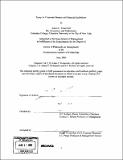Essays in corporate finance and financial institutions
Author(s)
Kolasinski, Adam
DownloadFull printable version (6.463Mb)
Other Contributors
Sloan School of Management.
Advisor
S.P. Kothari.
Terms of use
Metadata
Show full item recordAbstract
Chi: Subsidiary Debt, Capital Structure, and Internal Capital Markets I investigate external subsidiary debt financing and its implications for internal capital markets. I find that firms tend to finance business segments with subsidiary debt when those segments have better investment opportunities than the rest of the firm, and such debt tends to be parent-guaranteed. I also find that having such debt outstanding significantly reduces the effect of a segment's cash flow on the capital expenditures of other segments. These findings suggest that firms use subsidiary debt to protect their stronger segments from the underfunding or "poaching" problems modeled in theories of internal capital markets. In addition, I find that firms use subsidiary debt for reasons related to traditional capital structure concerns. Ch2: Is the Chinese Wall too High? I test whether new regulatory restrictions on cooperation between analysts and investment bankers adversely affect equity research coverage. Contrary to the hypothesis, I find that firms engaging in SEO's enjoy just as large an increase in analyst coverage in the post-regulatory period as they do in the pre-regulatory period. (cont.) In addition, while I find that analyst coverage in the post regulatory period significantly declines for new IPOs, it declines by an equal amount for a control group of comparable firms that pay no such fees. Making the identifying assumption that any adverse consequences of the new restrictions should be larger for IPO's, I conclude that the restrictions have no adverse impact on analyst coverage. Ch3: Investment Banking and Analyst Objectivity' This chapter uncovers evidence that conflicts of interest arising from M&A advisory relations influence analysts' recommendations, corroborating regulators' and practitioners' suspicions on a topic not previously examined in the academic literature. In addition, the M&A context allows us to disentangle the conflict of interest effect from selection bias. We find that analysts affiliated with acquirer advisors upgrade acquirer stocks around M&A deals, even around all-cash deals, wherein selection bias is unlikely. Also consistent with conflict of interest, but not selection bias, target-affiliated analysts publish optimistic reports about acquirers after, but not before, the exchange ratio of an all-stock deal is set.
Description
Thesis (Ph. D.)--Massachusetts Institute of Technology, Sloan School of Management, 2006. "June, 2006." Includes bibliographical references.
Date issued
2006Department
Sloan School of ManagementPublisher
Massachusetts Institute of Technology
Keywords
Sloan School of Management.